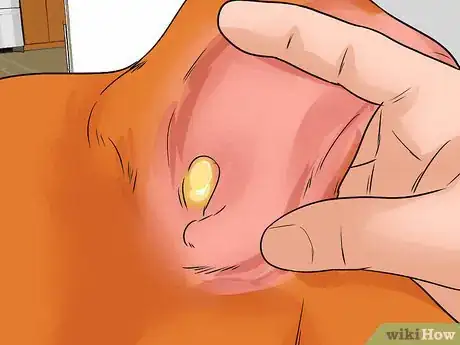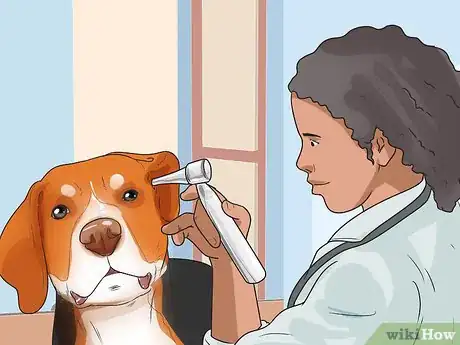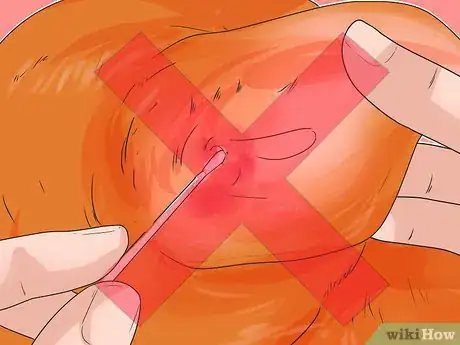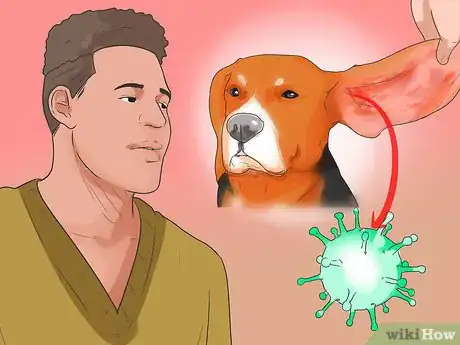This article was co-authored by Pippa Elliott, MRCVS. Dr. Elliott, BVMS, MRCVS is a veterinarian with over 30 years of experience in veterinary surgery and companion animal practice. She graduated from the University of Glasgow in 1987 with a degree in veterinary medicine and surgery. She has worked at the same animal clinic in her hometown for over 20 years.
This article has been viewed 16,181 times.
Beagles are vulnerable to ear infections because of the droopy nature of their ears. The Beagle has heavy ear flaps which droop down and cover the ear canal. While this is handy because it protects wind, rain, and dust from blowing inside their ears, the ear flap reduces the air circulating in the ear canal, which predisposes it to infection. Because of this, it's important for a Beagle owner to be aware of what to look for, so you can seek prompt treatment and minimize the discomfort of an ear infection.[1]
Steps
Recognizing The Symptoms of Ear Infections
-
1Watch for excessive scratching. Your Beagle may scratch his ear often if he has an infection. Watch for persistent scratching with a hindpaw or rubbing with a front paw against.[2]
- Your dog may also shake his head a lot.
-
2Notice any rubbing of the ear on the ground. Because the ear will be bothering your Beagle, watch for him to rub, drag, or scoot his ear along the ground. Rubbing the ear along the ground is another sign of irritation that may be due to an infection.[3]Advertisement
-
3Pay attention to whining. All dogs whine at some point. But whining sometimes indicates your dog is in pain. Since ear infections make the ears sore, the dog may whimper or whine.[4]
- Some dogs will scratch their ear while whining, indicating their ear hurts.
-
4Check for head tilting. Watch for your Beagle to hold his head to the side. Persistently holding the head to one side is a sign the ear on that side is sore.[5]
- This can also be a sign of a deep infection, and because of this, it's important to get the ear checked immediately.
-
5Notice any changes in behavior. Ear infections can be painful, and because of this, your dog’s behavior may change. An infection may prevent your dog from eating, or make him reluctant to go for a walk because his ear hurts. If you see changes in your dog’s behavior, see if you can determine the underlying problem.
- Your dog may also act more irritable than usual, or become depressed.[6]
-
6Check for unpleasant smells. Bacterial infections often give off an unpleasant odor. Sniff your dog’s ears to determine if they smell bad or different than normal.[7]
-
7Look for discharge. Look for any discharge from the ear canal. The discharge might be a thick, brown or black wax or a yellow-green infection.[8]
-
8Watch for skin redness or thickness. The skin of the ear may be reddened as a result of scratching or infection. If your dog’s ear has been irritated for a while, the skin may become thickened, greasy, or crusty.[9]
- Compare one side with the other to get an idea if the skin is normal or thickened.
-
9Look for trouble chewing. Sometimes, if the pain is bad enough, your dog may have trouble chewing. This is because it may be painful to open the mouth. Your dog might also be reluctant to chew.[10]
Diagnosing The Ear Infection
-
1Take your Beagle to the vet. If you notice any of the symptoms of an ear infection, then your Beagle should be checked by a vet.Take your dog to the vet as soon as you notice any problems. The earlier you catch the infection, the better for your dog.[11]
-
2Get an exam. When you take your dog to the vet, she will perform a physical examination. She will take a look at your dog’s ears to see if there is pain around the ear, a discharge, or physical changes in the ear. She will also look to see if the dog has a head tilt.[12]
- The vet will use an otoscope to look down the external ear canal. The otoscope is part magnifier and part light-source, and has a narrow cone which fits down the ear canal and allows the vet to look deep into the ear.
- The vet will carefully inspect the ear canal for inflammations, redness, ulcer, discharge, or a foreign body in the ear, such as a grass awn. If a discharge is present and the ear is sore, this is enough to diagnose an ear infection.
-
3Perform any additional tests. If the dog has ear infections often, or the infection is slow to respond to treatment, the vet may perform further tests. These tests include examining a discharge smear. This allows the vet to identify if simple common bacteria are present or more complex bacteria, check for ear mites, and identify yeasts. This can help target treatment.
- The vet may also send a swab away for culture. The lab grows the bugs that are present and then attempts to kill them with different antibiotics in order to tell which is the most effective antibiotic to use to get rid of the infection.[13]
-
4Treat the ear infection. If an ear infection is present, the vet will probably clean your dog's ears. Then, she may start with topical ear drops at the office containing medications against yeast, bacteria, or ear mites. You will probably be given ear drops, or an antibiotic or antifungal, for your dog to administer at home.[14]
Understanding Ear Infections
-
1Refrain from giving ear medication not prescribed by the vet. If your dog displays the symptoms of an ear infection, you shouldn’t just give him any ear medication. The ear infection might be due to a bacteria or yeast that the medicine doesn’t help. It’s better to take your dog to the vet to make sure he gets the proper treatment.[15]
-
2Check your dog’s ears daily. To help prevent ear infections, clean your dog’s ears regularly. When you give your Beagle a bath, make sure to dry the ears well.[16] Once a week you should check your Beagle’s ears.[17] Lift your dog’s ear flaps every day and inspect them quickly. Look for skin redness, excessive wax, or a discharge from the ear.[18]
- You should also give each ear a quick sniff to see if there is any unpleasant smell, which could indicate an infection.
- Compare one ear with the other. Often ear on one side is worse than the other and can indicate an infection.
-
3Know why the Beagle is prone to ear infections. The ear canal is lined with skin, and it tends to be warm and moist, which makes it a great environment in which bacterial or yeast infection can grow. Because a Beagle’s ears are so long, this traps bacteria inside.[19]
- The Beagle is also an energetic dog that loves to exercise in fields and woods, increasing the risk of grass awns getting into the ear. The Beagle also loves to swim, and if water gets into the ear canal, it makes the environment even more damp, and therefore favourable to infection.
- If your Beagle comes into contact with another dog that has ear mites, he might catch the ear mites and develop an ear mite infection.[20]
References
- ↑ http://www.beaglepro.com/beagle-ears
- ↑ http://www.vcahospitals.com/main/pet-health-information/article/animal-health/ear-infections-in-dogs-otitis-externa/750
- ↑ http://www.peteducation.com/article.cfm?c=2+2095&aid=273
- ↑ http://www.petmd.com/dog/conditions/ears/c_multi_otitis_media_interna
- ↑ http://www.petmd.com/dog/conditions/ears/c_multi_otitis_media_interna
- ↑ http://www.peteducation.com/article.cfm?c=2+2095&aid=273
- ↑ http://www.peteducation.com/article.cfm?c=2+2095&aid=273
- ↑ http://www.beaglepro.com/beagle-ears
- ↑ http://www.vcahospitals.com/main/pet-health-information/article/animal-health/ear-infections-in-dogs-otitis-externa/750
- ↑ http://www.petmd.com/dog/conditions/ears/c_multi_otitis_media_interna
- ↑ http://www.petmd.com/dog/conditions/ears/c_multi_otitis_media_interna
- ↑ http://www.vcahospitals.com/main/pet-health-information/article/animal-health/ear-infections-in-dogs-otitis-externa/750
- ↑ http://www.vcahospitals.com/main/pet-health-information/article/animal-health/ear-infections-in-dogs-otitis-externa/750
- ↑ http://www.petmd.com/dog/conditions/ears/c_multi_otitis_media_interna
- ↑ http://www.vcahospitals.com/main/pet-health-information/article/animal-health/ear-infections-in-dogs-otitis-externa/750
- ↑ http://www.beaglepro.com/beagle-ears
- ↑ http://www.peteducation.com/article.cfm?c=2+2095&aid=273
- ↑ http://www.petmd.com/dog/conditions/ears/c_multi_otitis_media_interna
- ↑ http://www.peteducation.com/article.cfm?c=2+2095&aid=273
- ↑ http://www.petmd.com/dog/conditions/ears/c_multi_otitis_media_interna
About This Article
To diagnose ear infections in your beagle, watch for symptoms, like your dog scratching its ear with the hind paw or rubbing its ear with the front paw. You may also notice your beagle rubbing its ear on the ground, whining in pain, or tilting its head to one side. Additionally, check for any brown or black discharge from its ears, which may be a sign of bacteria. If you notice any of these symptoms, take your beagle to the vet as soon as possible for a physical exam. After cleaning your dog's ears, your vet will give you ear drops, or an antibiotic or antifungal, for you to administer at home. For tips from our Veterinary co-author on how to treat an ear infection, read on!






































































